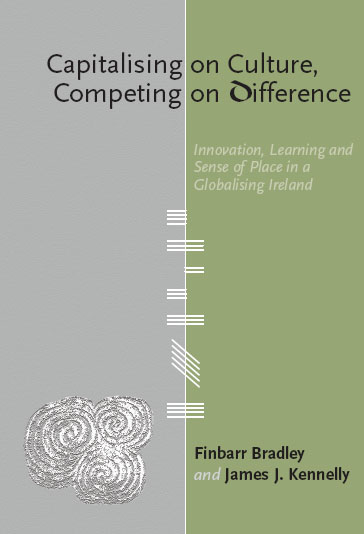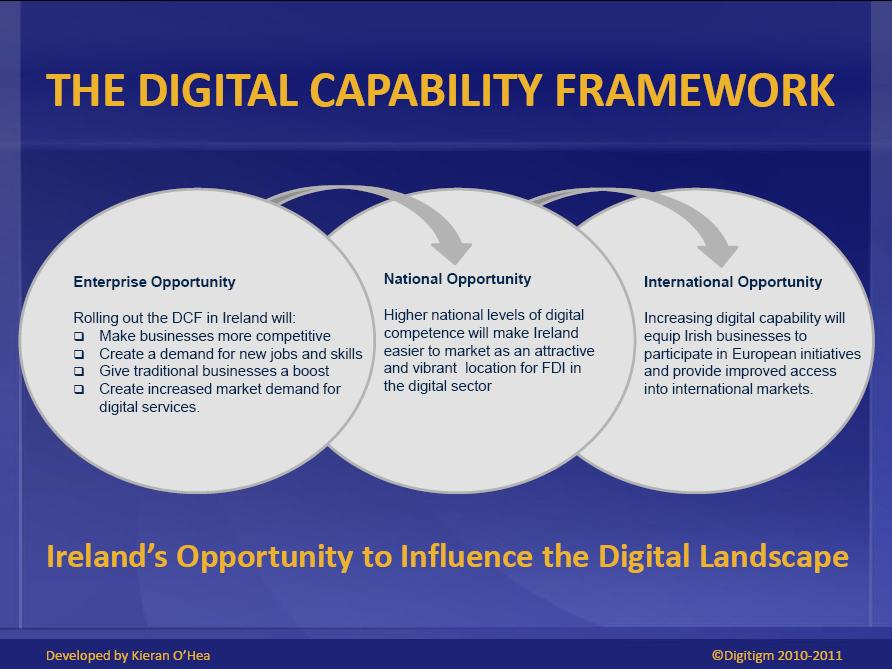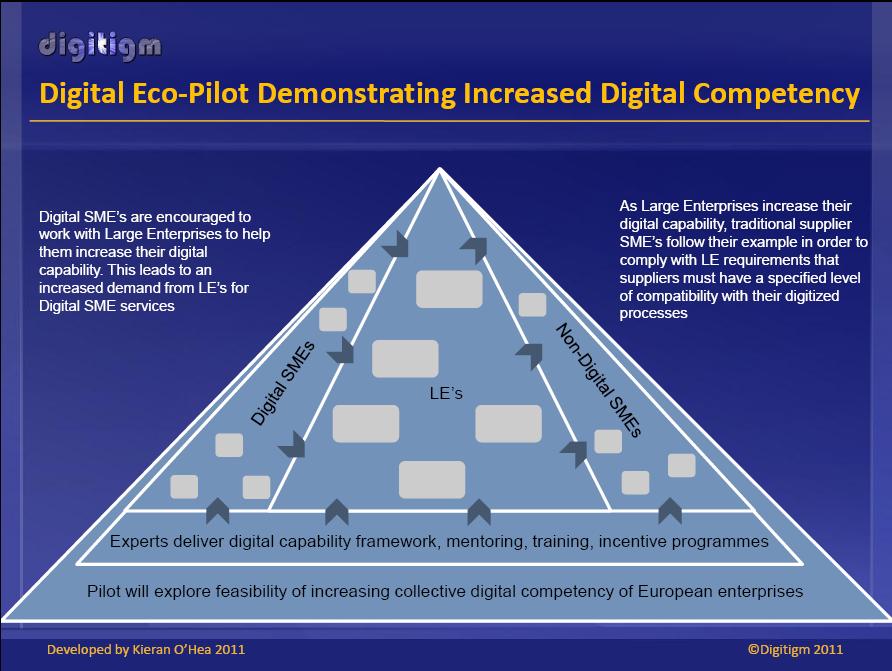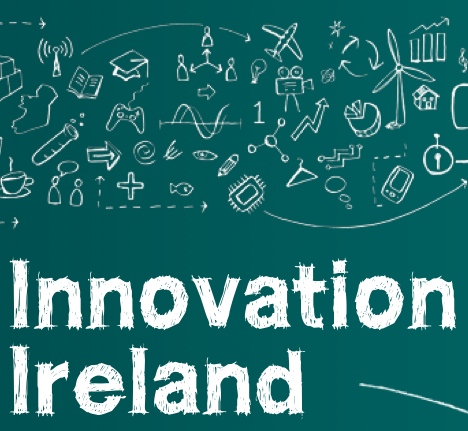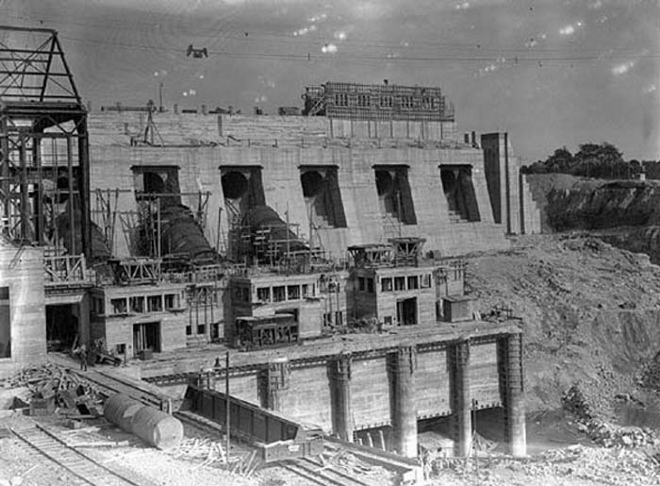Brilliant for its time ! – 1803
Innovating our Education Process to best exploit our indigenous creativity
Interview with Finbarr Bradley of Intinn
©Frank Hughes -originally posted on pivotdublin website 2011
Finbarr Bradley teaches part-time at the UCD Smurfit Business School while he also runs innovation programmes at a number of Irish and international companies. He co-authored with James Kennelly a 2008 book, Capitalising on Culture, Competing on Difference [Blackhall Publishing]
Who or what has inspired your thinking on Education in Ireland over the years and why?
My intellectual breakthrough was a realisation that education is not so much learning-about as learning-to-be. People educate themselves, they are not educated by others! Non-Irish inspiration has come from people like John Dewey, Elliot Eisner, Nikolaj Grundtvig, Howard Gardner, Paulo Freire, Jacques Maritain, Robert Chia, Henry Minzberg and Michael Porter. Irish inspiration has come from the likes of Thomas Davis ,Douglas Hyde, Pádraig Pearse, W.B. Yeats, George Russell (Æ), Horace Plunkett, Seán Ó Tuama, Seán de Fréine, Breandán Ó Doibhlin, E.Estyn Evans ,Patrick Lynch, Joe Lee and Michael Cronin. I was also inspired by great teachers, Christian Brother and lay, at the North Monastery , Cork. All opened my eyes, in one way or another, to the perspective that education transforms individuals, sustaining individual difference while enhancing a sense of belonging. Education is best generated within dynamic and vibrant learning environments which emphasize identity, experience and meaning, all driven by self-discovery and exploration. A person I mentioned earlier, philosopher John Dewey, classified education as a process of living and not as a preparation for future living. I understand the term ‘education’ in French means a lot more than academic learning and encompasses how individuals feel, what they eat,how they comport themselves, relate to others, and so forth. I agree.
How has the move from a more Agrarian Society to an Urban and Technology focused Society affected educational policy making in Ireland?
I feel we have moved too far away from where the country’s true potential lies. The current policy, which focuses too much on science and technology, does not place enough emphasis on tradition, culture and the arts. In my view social and cultural capital are key. We need to genuinely embrace our unique imaginative tradition which is fostered by belonging, purpose and idealism. While there is much debate on the need to restore the Irish economy, most of the commentary appears blind to the important role that culture might play in this endeavour. Yet as best-selling US author on globalisation Thomas Friedman put it, countries like Ireland ‘need to develop sufficiently strong cultural and environmental filters’ to operate successfully in today’s world.
The idea that a strong cultural identity is opposed to materialism, the profit motive, technological innovation and modernism, reflects an unfortunate legacy of the elites who governed this country over its first decades. In the space of eighty odd years, Ireland has moved from one extreme to another: from a place where culture featured prominently in the national vision to its opposite, where science, rationality and markets dominate. Educational policy should instead harness the positive elements of both, taking advantage of the country’s distinct characteristics.
I feel much can be learned from the resurgent cultural self-confidence of the late 1950s to mid 1960s. Outstanding figures of that era such as Seán Lemass and Seán Ó Riada possessed a sophisticated regard for tradition. While T.K. Whitaker was responsible for transforming the Irish economy and embracing the world, a strong cultural perspective was at the core of his economic vision. This year’s St. Patrick’s Day editorial in the Irish Times put it so well: ‘There will be no recovery worth its name without the spiritual, moral and cultural dimensions which renew Ireland’s self-understanding and confidence.’ Like physical infrastructure, cultural infrastructure needs investment too!
In light of the current emphasis on Innovation and Technology internationally and the presence of many of the world’s top technology companies in Ireland, how do you rate the Irish Education system’s ability to best exploit our creativity in these fields ?
I think education policy-makers have failed to draw proper lessons on where our future lies. The world is undergoing a fundamental shift from the industrial or manufacturing age of physical goods to a network age dominated by intangible services and experiences. The industrial enterprise is wedded to rationality and control rather than emotions, empathy and relationships, characteristics of today’s network organisation. As the significance of the material diminishes and capacities of the mind become more and more crucial, human attitudes and meaning become key resources. We are entering an era where patterns, context and the symbolic are crucial. Strong personal feelings and the ability to foster relationships are therefore critical.
Storytelling, metaphor, conversation, reflection, development of character and an ethic of quality are essential. Stories create a rich visual imagery through conversation, reflection and shared meaning. This is why Ireland’s cultural traditions are so valuable. Far from being dead artefacts that are anti-modern and non-economic, our heritage represents a significant asset that fosters innovation, creativity, entrepreneurship and meaning. Innovation is really about stories and the Irish are the world’s great story-tellers. In social networks, the Irish have natural advantages but these will only be fully realised if the artistic is combined with the scientific, interpreted through the prism of Irish culture and tradition.
This country’s tradition of metaphors, narrative and mythology, if integrated properly with science and technology, offers a huge competitive advantage. However, our current policy focuses largely on scientific research based on objectivity, denying the legitimacy of the subjective world of feeling, ignoring our distinct and valuable resource, a sense of connection and the imagination.The scientific mind simplifies and narrows experiences into manageable principles whereas literature and the arts emphasize complexity, crucial if entrepreneurial imagination and innovation is to flourish. While scientific research is certainly important, breakthrough ideas require intelligence of the heart and hand, not just intelligence of the head. Combining the scientific mind of separability and rationality with say Irish mythology, which is not linear but has a meandering interconnectedness, is ideal for the emerging sustainable age where conversation, empathy, meaning and relationships are critical.
What is your understanding of Integration in an Educational context and what benefits can it bring to our economic and cultural wellbeing?
While there are many ways of looking at integration in education, I see the pursuit of interdisciplinarity and wholeness at the heart of this concept. With regard to the former, both the arts and sciences involve instinct, intuition and imagination. For wholeness, it is crucial that cultural diversity and sustainability become central elements in learning. There is a direct link between the words integration and integrity. A key challenge is to help young people change their thinking from individual rights to collective responsibilities, independence to interdependence, luxuries to necessities, short-term to long-term thinking, and growth that benefits a few to development and vitality that benefits all. This implies a culture founded on the realisation of human potential and the interdependence of social, economic, and ecological well-being.
Young people should be helped to think globally but feel rooted in Ireland, so learning must emphasise a sense of place and shared meaning nurtured by experience. This is why here again the arts, in particular, grounded in the imagination and emotions, are so valuable. The arts engage the young person in transformative learning which includes the heart as well as the mind, balances intuition with analysis, focuses on character and community, and cultivates wisdom rather than mere accumulation of facts. The more practice and experience students have of contacting and exploring their inner emotional world the more confidently they can creatively deal with change and be open to new possibilities. The arts helps them to think holistically and work in multidisciplinary groups. At present, they often fail to see connections and patterns whereas in a sustainable or ecological view of the world, the emphasis is on relationships. Thinking is systemic rather than linear, integrative rather than fragmentary, concerned with process, emphasising dynamics rather than cause-effect and pattern rather than detail. So this is fundamentally about recognising wholeness or as put earlier, integrity.
Why do you think that a radical redesign of our educational system is necessary now ? What in your opinion are the specific blockers to an enlightened education system here and how might these be simply overcome?
A radical redesign is needed to nurture imagination, personal development, creativity and civic responsibility. At third level, interdisciplinary studies are crucial to innovation but because of the academic structuring of knowledge into the separate disciplines, integrated programmes that draw on the arts, humanities, science and technology are especially difficult to develop in Irish universities. Breaking down these barriers between specialisations can foster academic diversity and thereby individual creativity.The barriers are a major obstacle to nurturing an innovative culture within institutions that do not often satisfy real local needs.
In effect , faculty members see the esteem of international colleagues at other institutions at the core of their mission. Publishing research in peer-reviewed journals and presenting at international conferences are the most prestigious activities, not engaging with the (research) needs of the local community or local enterprises. The physical layout of the typical campus clearly demonstrates this:generally designed to ignore local engagement with local knowledge,heritage and traditions seen of little value or relevance to the mission of the institution.
Another specific blocker to an enlightened education comes from business and academic interests who have convinced policy-makers that culture has little to do with stimulating innovation. Yet culture is a core pillar of France, a country whose humanist ideals independent Ireland was based on. Italy also illustrates the importance of culture and meaning as a competitive strength. Italian design is impossible to imitate, a heritage of arts and crafts resources developed over generations, a critical innovative resource. Nordic countries have long recognised cultural rejuvenation as essential for national self-reliance with rootedness providing a quality aspirational work ethic and empowered innovative community. In Finland, a country Ireland is often urged to emulate, dynamic integration in the global economy, strong national sentiment, a unique language and closeness to nature, represent important sources of meaning. Irish commentators focus on that country’s huge R&D spend but do not appreciate that strong affirmation of its culture is the key and might similarly be a driver of innovation at home.
To overcome blockers, which I regard as essentially due to a failure of the spirit, we need to engage in the type of cultural rejuvenation that places like Denmark and Finland realised a long time ago. Contemporary Ireland is badly in need of the driving vision that characterised the Irish Cultural Revival, that period some thirty years before the foundation of the State. The Revival was an exhilarating mix of cultural cohesion, idealism, self-reliance and creativity, encompassing a range of innovative initiatives in commerce, agriculture, theatre, literature, sport and language all relating to a common theme: an awakening interest in Irish identity, broadly defined. But its exhilarating message seems lost nowadays on most politicians and those leading our education institutions.
What shape might a better adapted education system in Ireland take and why might it lead to more breakthrough innovations?
Education should mean more than simply preparing students for a job or cultivating the intellect. Educators should be concerned with students’ personal values and welfare, as well as their interpersonal and intercultural skills. These are at least as important as skills in science or mathematics in developing an innovative ethic. Too much emphasis on technical skills rather than fostering self-esteem, healthy relationships, and socially responsible behaviour is flawed. Educators should imbue ethical behaviour, or to use that old-fashioned word, character, within the education experience. Students must learn to think holistically, work in multidisciplinary groups, cope with change and develop systems and products that are sustainable and caring of nature and humanity.
It is difficult to identify a consistent theme flowing through Irish education, especially at third level. Many programmes, even ones within the same institution, appear to share no common mission or unifying narrative that can inspire or give meaning to the educational experience. Even though access to information is now widespread on the Internet, traditional lecturing, sometimes to classes of hundreds of students, is still the norm. What is learned can often not be carried beyond the classroom, so even students with highly developed knowledge of a subject find it difficult to put that to use except in the artificial world of university examinations. Students often lack a coherent body of knowledge, fail to see connections, and possess no clear sense of how one course is related to another. Learning should be based on cultivating the natural curiosity and impulse to learn of individuals rather than rewarding them for performing for the sake of others. This means learning in order to attain one’s own goals, guided by one’s own values, not the approval of an outsider such as a lecturer or teacher. All students should clearly understand from the time they arrive on campus the reason they are at university: it is to become a discoverer.
If students are confident at creatively dealing with change and open to new possibilities, they are better prepared for innovation. Perhaps the best way to nurture creativity and innovation would be for each Irish third level institution to pursue a clearly defined interdisciplinary purpose, in effect a roadmap to guide all its research and learning activities. The key challenge for educators is to structure programmes that would connect to this shared institutional mission through a seamless web or network of exploration. Across the university, whether in the arts, humanities, social or physical sciences, this is a challenge if higher education is to respond appropriately to the education needs of a learning society.
What do you mean by the Emotional Economy and how does this convert into hard currency?
The emerging Emotional Economy is one where experiences, meaning, patterns, context and the symbolic are crucial. Strong personal feelings and the ability to foster relationships become critical. Experiences are inherently personal, and exist only in the mind of an individual engaged on an emotional, physical, intellectual and spiritual level. Nurturing meaning by delivering experiences replicate the role that selling goods or delivering services played in the past.
Corporate value is increasingly tied up not in tangibles like buildings and production facilities but in intangibles such as customer relationships and brands. The Internet has amplified this trend, ensuring intangibles are more mobile and tradeable. For many companies, since these are their great untapped source of competitive advantage, a different mindset is needed to create value. Progressive businesses understand that the only way to differentiate their goods and services is to infuse them with emotion and artistry, the key to success in the emotional economy.
You have spoken and written much about the importance of Place and Rootedness as a prerequisite for a Creative Ecosystem to develop. Please elaborate.
The quality of knowledge depends on a point-of-view or cultural perspective, and is now more valuable than ever. Imagination, the most valuable knowledge resource of all, is driven primarily by emotions and feelings, the heart rather than rational mind, and nurtured through drama, poetry, literature, music and art. Imagination is founded on inspiration, identity, empathy, memory, tradition, belonging and trust. Pride in place, cultural traditions such as language and music along with a new emphasis on sustainability and biodiversity, should form the bedrock for an Irish Creative Ecosystem. In an innovation age, a sense of place is central to the learning and development process, contributing to wholeness, integrity, civic responsibility, aesthetic sensibility and ecological concern. Policies that recognise the specific nature and feelings of the population, even if latent or unexpressed, achieve an inimitable competitive advantage. This is why distinct cultural resources rooted in place are potentially an enormous competitive advantage for Ireland.
Capitalising on Culture , Competing on Difference 2008
Special places possess distinctive, inimitable, rare, not easily substitutable and valuable resources. Ireland possesses such resources in abundance providing conditions for creativity and innovation but these are not often appreciated fully nor harnessed properly. Creative places provide an integrated eco-system where all forms of creativity – artistic and cultural, technological and economic – take root and flourish. Its ‘qualities’, namely its special cultural, social and natural environment, are now crucial to its economic base. The implication is clear: places that emphasise community will attract and keep the most creative people and organisations, be the most innovative and have the highest quality of life. Creative people are clustering in places which offer ‘authenticity’, ‘uniqueness’ and lifestyles and diversity they crave. They are attracted by the qualities of a community, while this in turn attracts enterprise, reversing the traditional direction of development. Unlike the past where reducing the cost of business or clustering companies in industrial estates was central to development, attracting creative individuals to a place can now ensure its long-term competitiveness.
I cannot see Ireland building a vibrant creative society without a stronger sense of its place in the world. Our future lies in generating a self-help ethos in diverse creative, transformative, multicultural communities committed to place. Just as the Revival emphasised the authenticity of place in defining Irishness, a sense of shared place holds the key to creating a common identity and innovative mind frame. Prospering in a multicultural world requires individuals that possess a deep understanding of their own culture. With greater self-confidence there is usually more curiosity and openness to the outsider. It is essential to locate oneself in context, since grounded this way, people appreciate the cultural values of others with whom they must co-operate. While remaining open to outside influences, they learn to identify difference and appreciate distinctiveness. They are able to absorb many different ideas, yet are not dominated by globalised cultural influences. But many immigrants today say the Irish appear to lack a clear sense of themselves and their own culture.
Digital Natives is a term used to describe people who have grown up with digital technology and is second nature to them. How do you see cultural, economic and digital maturity evolving in this country?
I can only see these evolving in tandem if a radical attitude is fostered, creativity developed and idealism generated. It will happen if young people obtain, along with exposure to practical problems-solving skills in digital technology, obtain a thorough understanding of the important role that tradition, place and culture play in sustainable innovation. Educators must nurture communities where students learn for themselves rather than merely receive information and knowledge from teachers or lecturers. Digital natives will emerge from an education environment in which students do practical work, make decisions, work as members of teams and both compete and cooperate. It will be stimulated by giving them a strong international identity alongside a strong local identity, developing an independent attitude and fostering self-confidence, a strong moral ethos and a spiritual dimension.
A radical change would clearly be necessary to assess student performance for transformative learning. Traditional testing by means of examinations should be the exception rather than rule. Innovative assessment methods based on subjective or qualitative criteria rather than traditional testing by means of examinations should be central. For instance, in the case of a collaborative project involving the local community, this should be assessed not just by using quantitative criteria such as economic return but also the social and environmental contribution the project is likely to make to the long-term sustainability of the community. Since tacit knowledge should be emphasised more than codified knowledge, assessment should be based not on an exam but rather on implementation of imaginative and innovative projects.
What should educators do to develop an ethic of citizenship among students?
I believe the absence of an ethic of civic responsibility is one of our largest social problems. Citizenship cannot be taught but may be learned if educators create an environment where tradition, identity and community are respected and valued. If the social or cultural context is ignored, investment in science and technology is not money well spent. For a culture of innovation to take root, it must nurture relationships of community and trust. An engaged school or university, those that actively encourages a culture of mutual respect and purposeful activities involving teachers, students and members of the community, is ideal for fostering the creative spirit. This would help if students had opportunities, as a central feature in their education, to engage with and learn from the local community. Education for creativity must foster idealism and identity to invigorate civil society. For as long as young people believe their vision can change the world, they are motivated, willing to lead change and be creative.
In a global economy, where change is the only certainty, identity formation is the crucial attribute. Students at all levels should be helped define a life purpose and the opportunity to undergo a transformative experience. They must be equipped to live as responsible citizens in complex multicultural societies while still upholding the richness and uniqueness of their own culture. Fostering self-esteem, a culture of pride, a climate of success, healthy relationships and socially responsible behaviour is the priority. Educators should imbue ethical behaviour or character within the education experience so students learn to think holistically, cope with change and appreciate a sustainable ethic. Citizenship implies sharing resources, not maximising one’s own interest. This depends on young people having an enduring sense of self-worth. Practical patriotism must be fostered and promoted so students emerge with a clear recognition of what it means to be Irish, a sense of ownership of the country and responsibility to use their knowledge, skills, and energy on its behalf.
LINKS :
Website and Biography

